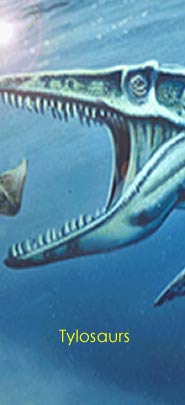
|
 |
||||
Family: Mosasauridae
Subfamily: Tylosaurinae
Genus: Hainosaurus
Species: pembinensis
Hainosaurus pembinensis Nicholls, 1988
Bruce lived during the late Cretaceous period, approximately 80 million years ago. He swam in a deep sea environment with numerous other marine reptiles. This ocean is termed the Western Interior Seaway and split North America in two. The Seaway spanned from the frigid waters of the Arctic Ocean to the warm currents of the Gulf of Mexico.
Bruce belonged to a group of Mosasaurs called the Tylosaurs. These Tylosaurs were the largest of the Mosasaurs, Bruce being the largest within Canada for this time period, approximately 43 feet long (~13m) from snout to tail. Bruce was a fierce predator, top of the food chain in the Seaway eating anything it its path from plesiosaurs to ammonites (shelled organisms).
The tail of Bruce is exceptionally long, moving side to side to propel him forward with snake-like undulations, while the large flippers primarily steered. Palaeontologists think the Mosasaurs lineage was branched off from a lizard group know today as the Monitor Lizards.
In 1974 Bruce was discovered north of Thornhill within the Pembina Member
of the Pierre Shale Formation. It took approximately two field seasons to
excavate the skeleton. The skeleton was reasonably complete with 65-70% of
the original bones.